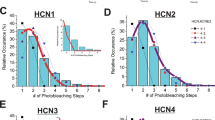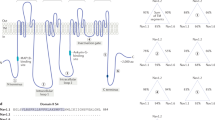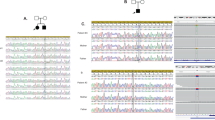Abstract
The large conductance calcium-sensitive potassium (BK) channel is widely expressed in many organs and tissues, but its in vivo physiological functions have not been fully defined. Here we report a genetic locus associated with a human syndrome of coexistent generalized epilepsy and paroxysmal dyskinesia on chromosome 10q22 and show that a mutation of the α subunit of the BK channel causes this syndrome. The mutant BK channel had a markedly greater macroscopic current. Single-channel recordings showed an increase in open-channel probability due to a three- to fivefold increase in Ca2+ sensitivity. We propose that enhancement of BK channels in vivo leads to increased excitability by inducing rapid repolarization of action potentials, resulting in generalized epilepsy and paroxysmal dyskinesia by allowing neurons to fire at a faster rate. These results identify a gene that is mutated in generalized epilepsy and paroxysmal dyskinesia and have implications for the pathogenesis of human epilepsy, the neurophysiology of paroxysmal movement disorders and the role of BK channels in neurological disease.
This is a preview of subscription content, access via your institution
Access options
Subscribe to this journal
Receive 12 print issues and online access
$209.00 per year
only $17.42 per issue
Buy this article
- Purchase on Springer Link
- Instant access to full article PDF
Prices may be subject to local taxes which are calculated during checkout





Similar content being viewed by others
Accession codes
References
World Health Organization. World Health Report 2002. (World Health Organization, Geneva, Switzerland, 2002).
Guerrini, R. Idiopathic epilepsy and paroxysmal dyskinesia. Epilepsia 42, 36–41 (2001).
Guerrini, R. et al. Early-onset absence epilepsy and paroxysmal dyskinesia. Epilepsia 43, 1224–1229 (2002).
Noebels, J.L. The biology of epilepsy genes. Annu. Rev. Neurosci. 26, 599–625 (2003).
Browne, D.L. et al. Episodic ataxia/myokymia syndrome is associated with point mutations in the human potassium channel gene, KCNA1. Nat. Genet. 8, 136–140 (1994).
Shi, J. et al. Mechanism of magnesium activation of calcium-activated potassium channels. Nature 418, 876–880 (2002).
Xia, X.M., Zeng, X. & Lingle, C.J. Multiple regulatory sites in large-conductance calcium-activated potassium channels. Nature 418, 880–884 (2002).
Adams, P.R., Constanti, A., Brown, D.A. & Clark, R.B. Intracellular Ca2+ activates a fast voltage-sensitive K+ current in vertebrate sympathetic neurones. Nature 296, 746–749 (1982).
Bao, L., Rapin, A.M., Holmstrand, E.C. & Cox, D.H. Elimination of the BK(Ca) channel's high-affinity Ca(2+) sensitivity. J. Gen. Physiol. 120, 173–189 (2002).
McManus, O.B. et al. Functional role of the beta subunit of high conductance calcium-activated potassium channels. Neuron 14, 645–650 (1995).
Nimigean, C.M. & Magleby, K.L. The beta subunit increases the Ca2+ sensitivity of large conductance Ca2+-activated potassium channels by retaining the gating in the bursting states. J. Gen. Physiol. 113, 425–440 (1999).
Fernandez-Fernandez, J.M. et al. Gain-of-function mutation in the KCNMB1 potassium channel subunit is associated with low prevalence of diastolic hypertension. J. Clin. Invest. 113, 1032–1039 (2004).
Jin, W., Sugaya, A., Tsuda, T., Ohguchi, H. & Sugaya, E. Relationship between large conductance calcium-activated potassium channel and bursting activity. Brain Res. 860, 21–28 (2000).
Lancaster, B. & Nicoll, R.A. Properties of two calcium-activated hyperpolarizations in rat hippocampal neurones. J. Physiol. (Lond.) 389, 187–203 (1987).
von Krosigk, M., Bal, T. & McCormick, D.A. Cellular mechanisms of a synchronized oscillation in the thalamus. Science 261, 361–364 (1993).
McCormick, D.A. & Pape, H.C. Properties of a hyperpolarization-activated cation current and its role in rhythmic oscillation in thalamic relay neurones. J. Physiol. (Lond.) 431, 291–318 (1990).
Davies, A.G. et al. A central role of the BK potassium channel in behavioral responses to ethanol in C. elegans . Cell 115, 655–666 (2003).
Lee, H.Y. et al. The gene for paroxysmal non-kinesigenic dyskinesia encodes an enzyme in a stress response pathway. Hum. Mol. Genet. 13, 3161–3170 (2004).
Sausbier, M. et al. Cerebellar ataxia and Purkinje cell dysfunction caused by Ca2+-activated K+ channel deficiency. Proc. Natl. Acad. Sci. USA 101, 9474–9478 (2004).
Ruttiger, L. et al. Deletion of the Ca2+-activated potassium (BK) alpha-subunit but not the BKbeta1-subunit leads to progressive hearing loss. Proc. Natl. Acad. Sci. USA 101, 12922–12927 (2004).
Szepetowski, P. et al. Familial infantile convulsions and paroxysmal choreoathetosis: a new neurological syndrome linked to the pericentromeric region of human chromosome 16. Am. J. Hum. Genet. 61, 889–898 (1997).
Guerrini, R. et al. Autosomal recessive rolandic epilepsy with paroxysmal exercise-induced dystonia and writer's cramp: delineation of the syndrome and gene mapping to chromosome 16p12–112. Ann. Neurol. 45, 344–352 (1999).
Lubbers, W.J. et al. Hereditary myokymia and paroxysmal ataxia linked to chromosome 12 is responsive to acetazolamide. J. Neurol. Neurosurg. Psychiatry 59, 400–405 (1995).
Eunson, L.H. et al. Clinical, genetic, and expression studies of mutations in the potassium channel gene KCNA1 reveal new phenotypic variability. Ann. Neurol. 48, 647–656 (2000).
Commission on Classification and Terminology of the International League Against Epilepsy. Proposal for revised clinical and electroencephalographic classification of epileptic seizures. Epilepsia 22, 489–501 (1981).
Commission on Classification and Terminology of the International League Against Epilepsy. Proposal for revised classification of epilepsies and epileptic syndromes. Epilepsia 30, 389–399 (1989).
Demirkiran, M. & Jankovic, J. Paroxysmal dyskinesias: clinical features and classification. Ann. Neurol. 38, 571–579 (1995).
Wang, L., Fan, C., Topol, S.E., Topol, E.J. & Wang, Q. Mutation of MEF2A in an inherited disorder with features of coronary artery disease. Science 302, 1578–1581 (2003).
Barrett, J.N., Magleby, K.L. & Pallotta, B.S. Properties of single calcium-activated potassium channels in cultured rat muscle. J. Physiol. (Lond.) 331, 211–230 (1982).
Acknowledgements
We thank I.B. Levitan, Y. Zhou, L. Salkoff and A. Butler for the expression constructs for KCNMA1; the study participants for their enthusiasm for and support of this study; L. Li for lod score calculation; S. Yong, G. Kirsch, C.J. Lingle, T. Zhang, A. Alexopoulos and I. Najm for help and discussion; and R. Guerrini for providing DNA from two individuals with epilepsy and paroxysmal dyskinesia3 (no KCNMA1 mutation was identified in these two DNA samples). This work was supported by grants from the US National Institutes of Health (Q.K.W., J.F.B., G.B.R. & A.D.-S. and J.C.), an American Heart Association Established Investigator award (Q.K.W.), the VAMC (G.B.R.) and a Clinical Research Training Fellowship from the American Academy of Neurology Foundation (J.F.B.). This work was supported in part by the Chinese Ministry of Science and Technology National High Technology 863 Project grant (Q.K.W.) and a Public Health Service National Center for Research Resources grant at the Cleveland Clinic Foundation (Q.K.W.).
Author information
Authors and Affiliations
Corresponding author
Ethics declarations
Competing interests
The authors declare no competing financial interests.
Supplementary information
Supplementary Fig. 1
KCNMA1 mutation D434G co-segregates with GEPD patients in the family. (PDF 106 kb)
Rights and permissions
About this article
Cite this article
Du, W., Bautista, J., Yang, H. et al. Calcium-sensitive potassium channelopathy in human epilepsy and paroxysmal movement disorder. Nat Genet 37, 733–738 (2005). https://doi.org/10.1038/ng1585
Received:
Accepted:
Published:
Issue Date:
DOI: https://doi.org/10.1038/ng1585
This article is cited by
-
Pulmonary Circulation Under Pressure: Pathophysiological and Therapeutic Implications of BK Channel
Cardiovascular Drugs and Therapy (2023)
-
Damaging novel mutations in PIGN cause developmental epileptic-dyskinetic encephalopathy: a case report
BMC Pediatrics (2022)
-
Inhibition of BKCa channels protects neonatal hearts against myocardial ischemia and reperfusion injury
Cell Death Discovery (2022)
-
Invertebrate neurons as a simple model to study the hyperexcitable state of epileptic disorders in single cells, monosynaptic connections, and polysynaptic circuits
Biophysical Reviews (2022)
-
Genetic updates on paroxysmal dyskinesias
Journal of Neural Transmission (2021)



